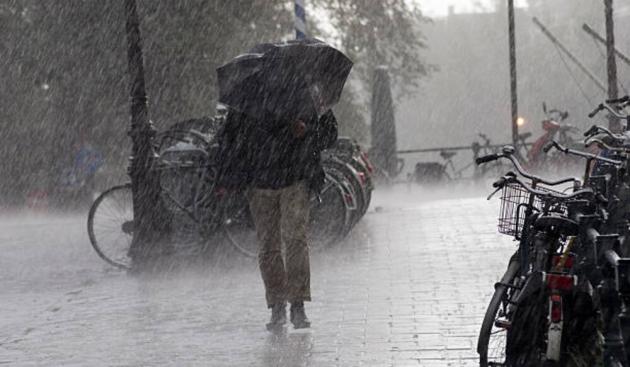The Meteorology, Climatology, and Geophysics Agency (BMKG) projects that rainfall in several regions of Indonesia will increase in the coming week.
This condition is expected to cause rain with moderate to heavy intensity, which in some cases may be accompanied by lightning and strong winds.
In the weekly weather outlook for the period of 19 to 25 August, BMKG explained that the increase in rainfall is influenced by a combination of various global and regional atmospheric factors.
One of them is the activity of the Madden-Julian Oscillation (MJO), which is currently in phase 3 and triggers the growth of rain clouds in the western region of Indonesia.
This phenomenon is reinforced by the presence of atmospheric waves, namely Mixed Rossby-Gravity and Kelvin Waves, as well as the existence of a positive Outgoing Longwave Radiation (OLR) anomaly, which indicates increased convective activity.
On the other hand, a cyclonic circulation is observed in the Indian Ocean west of Sumatra, which plays a role in slowing and diverting wind direction, thereby increasing the chance of rain cloud formation.
“These factors cause rainfall to increase while most regions are still in the dry season period,” wrote BMKG in its official statement.
BMKG added that the Dipole Mode index, currently at -0.84, also contributes by increasing the supply of water vapor from the Indian Ocean west of Sumatra.
Meanwhile, the MJO phenomenon is predicted to continue strengthening and transition to phase 4 with broader coverage into Indonesian territory.
A number of regions are also expected to become centers of convective cloud growth. Kelvin Waves and Mixed Rossby-Gravity are detected as active in Lampung, Java, South Kalimantan, Sulawesi, and parts of Maluku.
Low-frequency waves are also still active in South Sumatra, western Java, and parts of central to eastern Indonesia.
Cyclonic circulation in the Indian Ocean west of Sumatra also forms a convergence zone from Lampung to the southwest of Banten.
In addition, BMKG notes the presence of other convergence lines extending across several regions, from Central Java and East Java, the Java Sea, Central Sulawesi to Southeast Sulawesi, Maluku to Tomini Bay, and West Papua to the mountainous regions of Papua.
Meteorology, Climatology, and Geophysics Agency (BMKG)
The Meteorology, Climatology, and Geophysics Agency (BMKG) is Indonesia’s national institution responsible for providing weather, climate, and geophysical services. It was officially established in its current form in 2008, but its origins trace back to Dutch colonial-era weather observation posts in the 19th century. The agency is critical for monitoring natural hazards like earthquakes and tsunamis and for issuing public warnings to protect the Indonesian archipelago.
Madden-Julian Oscillation (MJO)
The Madden-Julian Oscillation (MJO) is not a physical place but a major atmospheric phenomenon, first identified by Roland Madden and Paul Julian in 1971. It is an eastward-moving disturbance of clouds, rainfall, winds, and pressure that traverses the planet in the tropics, recurring every 30 to 60 days. This climate pattern is a primary driver of weather variability in the tropics and has significant influence on global weather events, including monsoons and hurricanes.
Mixed Rossby-Gravity
I’m sorry, but “Mixed Rossby-Gravity” is not a place or cultural site. It is a scientific term for a specific type of atmospheric or oceanic wave that plays a major role in Earth’s weather and climate systems, particularly in the tropics. These waves are a fundamental concept in meteorology and physical oceanography.
Kelvin Waves
Kelvin waves are not a physical place or cultural site, but a scientific concept in oceanography and atmospheric science. They are a type of wave trapped along boundaries like coastlines or the equator and are crucial for understanding climate patterns like El Niño. The phenomenon is named after the 19th-century physicist and engineer Lord Kelvin (William Thomson).
Outgoing Longwave Radiation (OLR)
Outgoing Longwave Radiation (OLR) is not a physical place or cultural site, but a scientific measurement used in climatology and meteorology. It refers to the energy radiating from the Earth’s surface and atmosphere out into space, which is a critical component of the planet’s energy budget. The study of OLR data, collected by satellites since the 1970s, is essential for understanding climate patterns, the greenhouse effect, and monitoring weather systems.
Dipole Mode
The Dipole Mode is not a physical place or cultural site, but a climate pattern in the Indian Ocean. It is characterized by the difference in sea surface temperatures between the ocean’s western and eastern basins, influencing regional weather. A positive phase, for example, is historically associated with increased rainfall in East Africa and drought conditions in Australasia.
Indian Ocean
The Indian Ocean is the world’s third-largest ocean, bounded by Africa, Asia, Australia, and the Southern Ocean. It has been a critical region for trade and cultural exchange for millennia, historically connecting the Middle East, East Africa, India, and Southeast Asia through monsoon-powered maritime routes.
Tomini Bay
Tomini Bay is a large bay located in the Gulf of Tomini, which indents the northern coast of Sulawesi, Indonesia. Historically, its coastal regions were part of ancient trading networks and were later influenced by Dutch colonial presence. Today, it is known for its rich marine biodiversity, coral reefs, and as a significant area for fishing and diving.






